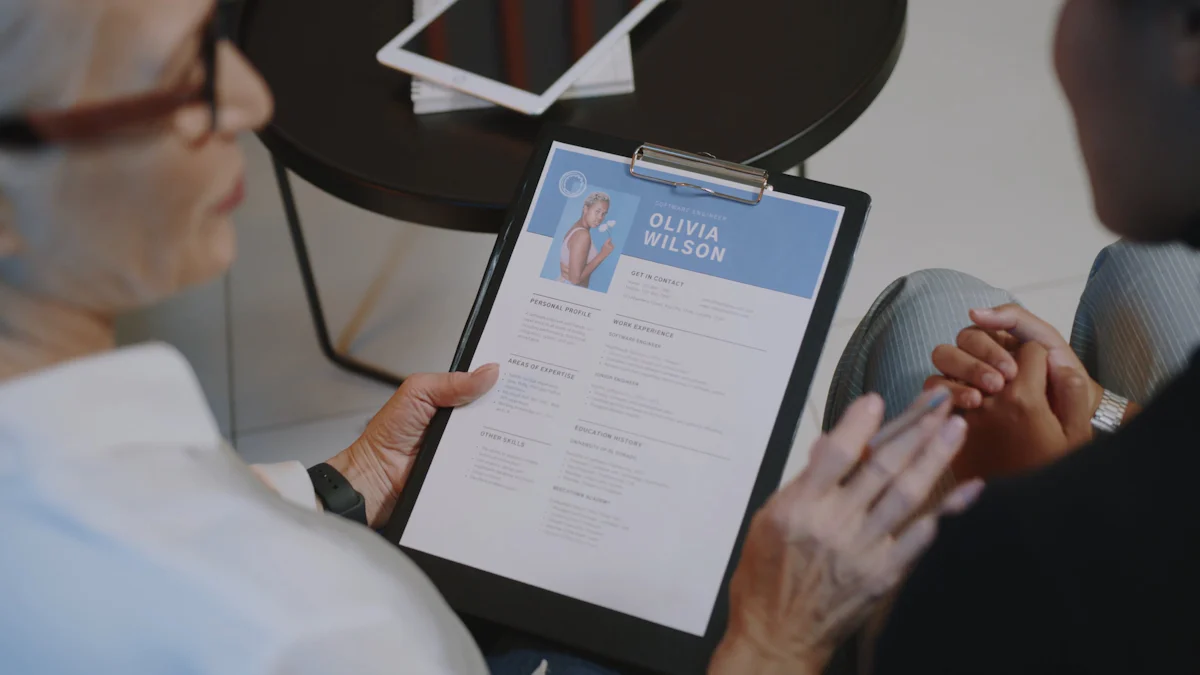Top Resume Format Tips to Stand Out in 2025
Try Aihirely for
Smarter Interview Prep
Experience real-time AI support tailored to your Resume.
Boost your confidence and ace every question with
AI Mock Interview.

Image Source: pexels
Your resume is your first impression. In 2025, recruiters and applicant tracking systems (ATS) demand more than just content—they expect a polished format. Did you know 83% of recruiters prefer well-formatted resumes? Yet, 68% reject poorly formatted ones. Keep it simple for ATS. Avoid graphics. Use the best format for resume success.
Pro Tip: A visually appealing resume boosts your chances by 73%. Vibrant colors? 75% of job seekers swear by them!
Key Statistics on Resume Formatting:
| Statistic | Percentage |
|---|---|
| Recruiters more likely to hire candidates with a well-formatted resume | 83% |
| Hiring managers who would reject poorly formatted resumes | 68% |
| Hiring managers who prefer visually appealing resumes | 73% |
| Job seekers using vibrant color palettes instead of default colors | 75% |
Why Formatting Matters for ATS and Recruiters:
-
ATS scores resumes based on keywords like job titles and qualifications.
-
Simple fonts and layouts ensure ATS readability.
-
Complex designs or graphics confuse ATS, reducing your chances.
Key Takeaways
-
Pick the best resume style for your job level. Use a skills-based resume if you lack experience or switch jobs. Use a timeline resume if you are experienced.
-
Make your resume easy for computers to read. Use simple fonts, clear titles, and no pictures. This helps recruiters find you faster.
-
Show your successes with strong action words and numbers. This makes your work stand out and shows its value.
Best Format for Resume: Overview of Top Options
Choosing the best format for resume success depends on your career stage and goals. Let’s explore the top options and when to use them.
Reverse-Chronological Resume
This is the most popular format. It lists your work history starting with your most recent job. Recruiters love it because it highlights career progression and professional stability. However, it might not work well if you have employment gaps or unrelated experience.
| Advantages | Disadvantages |
|---|---|
| Highlights career progression | Potential to highlight employment gaps |
| Meets standard recruiter expectations | Can emphasize irrelevant experience |
| Highlights professional stability | Might overshadow skills |
Use this format for traditional job applications or when your career history aligns with the role.
Functional Resume
A functional resume focuses on your skills and experience rather than your job history. It’s perfect if you’re switching careers, have limited experience, or gaps in employment.
Who benefits most?
-
Job seekers with employment gaps
-
Career changers
-
New graduates
This format lets you showcase your abilities without drawing attention to your work history.
Combination Resume
The combination resume blends the best of both worlds. It highlights your skills first, followed by your work history. This format is great for showing off your qualifications while still providing a timeline of your experience.
Why choose it?
-
It balances skills and work history.
-
It helps hiring managers assess your qualifications easily.
-
It’s ideal for roles requiring both expertise and experience.
If you want to emphasize your skills but still include your job history, this is the best format for resume versatility.
Infographic Resume
An infographic resume uses visuals like charts, icons, and colors to present your information. It’s eye-catching and creative, but not ATS-friendly. Use it only for industries where design skills matter.
Top industries for infographic resumes:
-
Marketing and Advertising
-
Digital Media and Social Media Management
-
UX/UI Design
-
Creative Writing and Content Creation
Stick to traditional formats for ATS, but bring out the infographic resume for creative roles.
Mini Resume
A mini resume is a short summary of your career highlights. It’s perfect for networking events, job fairs, or conferences. Think of it as a more detailed business card. You can hand it out to contacts who might share it with recruiters.
This format works well when you need a quick introduction to your qualifications. It’s not for formal applications but shines in professional settings.
Choosing the Best Format for Resume Based on Your Needs
Not all resumes are created equal, and your career stage plays a big role in choosing the right one. Let’s break it down so you can find the best fit for your situation.
New Graduates
Starting your career can feel overwhelming, but the right resume format makes a huge difference. As a new graduate, you might not have much work experience, but you can still shine by showcasing your skills and achievements. Here are some formats that work well:
-
Functional Resume: Highlight skills gained from academic projects, training, or extracurricular activities.
-
Chronological Resume: Perfect if you’ve done internships, volunteer work, or part-time jobs.
-
Combination Resume: A great choice if you have both skills and relevant experiences to share.
Focus on what you bring to the table, even if it’s not traditional work experience.
Career Changers
Switching careers? You’ll want a format that emphasizes transferable skills over job history. A functional resume works wonders here, letting you spotlight abilities that align with your new field. If you’ve gained relevant experience through side projects or freelance work, a combination resume can help you showcase both skills and a timeline of your efforts. The goal is to show how your past experience connects to your future role.
Experienced Professionals
If you’ve been in the workforce for years, your resume should highlight your expertise and career growth. These formats work best:
-
Reverse Chronological Resume: Show off your career progression and industry experience.
-
Combination Resume: Balance your skills and work history for a well-rounded view.
-
Targeted Resume: Tailor your resume to specific roles, focusing on relevant achievements.
For creative fields, an infographic resume can visually showcase your accomplishments.
Industry-Specific Preferences
Some industries have unique expectations for resumes. Creative fields like graphic design or marketing might favor infographic resumes, while traditional industries like finance or law prefer reverse chronological formats. Research your industry to ensure your resume aligns with what recruiters expect. This small step can make a big impact.
Choosing the best format for resume success depends on your goals and the impression you want to leave. Tailor your approach, and you’ll stand out every time.
Optimizing Resumes for ATS and Human Recruiters

Image Source: pexels
ATS-Friendly Formatting Tips
Getting past an ATS can feel tricky, but it’s easier when you know what works. These systems scan resumes for specific details, so your formatting needs to be simple and clear. Here’s how you can make your resume ATS-friendly:
-
Use common headings such as Summary, Work Experience, Education, and Skills.
-
Avoid images, columns, tables, or graphics.
-
Save your resume as a .doc or .txt file.
-
Keep margins and spacing consistent throughout.
-
Limit your resume to one or two pages.
Also, consider using ATS-friendly templates. These templates are designed to ensure your resume gets read by both ATS and recruiters. Remember, the best format for resume success combines clarity and professionalism.
Enhancing Human Readability
Once your resume passes the ATS, it needs to impress a recruiter. A clean, easy-to-read layout makes a big difference. Use bullet points to break up text and highlight key achievements. Keep section headings bold and clear so recruiters can quickly find what they need.
Use action verbs to describe your accomplishments. For example, instead of saying “Responsible for managing a team,” try “Led a team of 10 to achieve a 20% increase in sales.” This approach grabs attention and shows results.
Avoiding Common Resume Mistakes
Formatting mistakes can cost you an interview. Here are some common errors to avoid:
| Formatting Mistake | Description |
|---|---|
| Overly Complicated Design | Makes it hard for recruiters to find important details. |
| Inconsistent Font Sizes and Styles | Creates a messy, unprofessional appearance. |
| Lack of Clear Section Headings | Makes navigation difficult for hiring managers. |
A poorly formatted resume can confuse recruiters and lead to rejection. Keep it simple, professional, and polished to make the best impression.
Practical Formatting Tips for Key Resume Sections
Contact Information
Your contact information is the first thing recruiters see, so make it count. Keep it simple and professional. Include the following:
-
Full name
-
Phone number
-
Email address
-
Location (city and state)
-
LinkedIn profile (if relevant)
Avoid adding unnecessary details like your full address or personal social media links. A clean and concise contact section ensures recruiters can easily reach you.
Work Experience
Your work experience section tells your career story. Start with your most recent job and work backward. Use bullet points to describe your responsibilities and achievements. Focus on measurable results. For example, instead of saying, “Managed a team,” try, “Led a team of 10 to increase sales by 15%.” This approach shows impact and grabs attention. Keep job titles, company names, and dates consistent in format.
Skills Section
Organizing your skills effectively can make a big difference. Group them into categories that match the job description. Here’s a quick guide:
| Skill Category | Description |
|---|---|
| Strategic Skills | Organize skills into clear groups based on employer needs. |
| Technical Skills | List programs and tools with skill levels and relevant certifications. |
| Management Skills | Describe leadership experiences and project management capabilities. |
| Industry Knowledge | Include knowledge of current trends and relevant training. |
| Soft Skills | Provide examples of teamwork and communication successes. |
This structure makes it easy for recruiters to spot your qualifications.
Education and Certifications
Highlighting your education and certifications can boost your resume’s appeal. Follow these tips:
-
Create a section titled “Education and Certifications” or separate them if needed.
-
List the full title of the certification, including abbreviations.
-
Mention the issuing organization for credibility.
-
Add the date earned or last renewed.
Optional Sections (e.g., Projects, Volunteer Work)
Optional sections like projects or volunteer work can add depth to your resume. Include community volunteer work to showcase teamwork and leadership. Highlight significant projects to demonstrate your contributions. Tailor these experiences to match the job description. For students or recent grads, adding academic achievements or relevant coursework can strengthen your resume.
Including these sections strategically can help you create the best format for resume success.
Choosing the right resume format in 2025 can make or break your job search. A combination resume stands out as a versatile option, letting you showcase skills and experience effectively. Whether you’re a seasoned professional or just starting out, pick a format that aligns with your career goals. Tailor it to each role by using relevant keywords, highlighting achievements, and keeping the layout professional. Remember, recruiters love resumes that are clear, concise, and easy to navigate. Take these tips, apply them, and create a resume that gets you noticed. Your dream job is waiting—go get it!
FAQ
What is the best resume format for someone with no work experience?
The functional resume works best. It highlights your skills, academic projects, and extracurricular activities instead of focusing on job history. This format helps you stand out as a beginner.
Can I use colors or graphics on my resume?
Yes, but only for creative roles. Keep it simple for ATS. Use subtle colors sparingly and avoid graphics unless you’re applying for design or marketing positions.
Tip: Always save a plain-text version for ATS compatibility.
How long should my resume be?
Stick to one page if you’re new to the workforce. Experienced professionals can extend to two pages. Keep it concise and focus on relevant achievements.
Pro Tip: Recruiters spend only 6-7 seconds scanning resumes. Make every word count!
